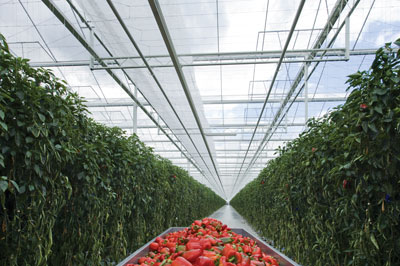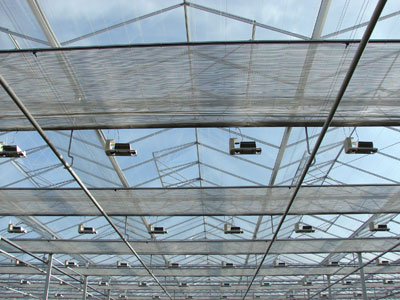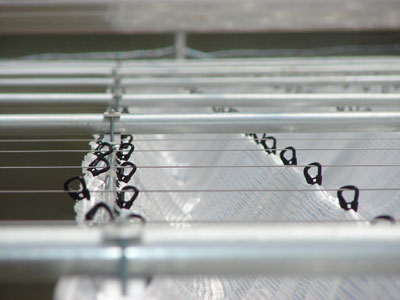
Some greenhouse operators keen to cut their energy bills are finding the
installation of double energy curtain systems to be a wise move.
Some greenhouse operators keen to cut their energy bills are finding the installation of double energy curtain systems to be a wise move.
 |
|
| Screening in a pepper greenhouse. PHOTO COURTESY SVENSSON Advertisement
|
Linked into the greenhouse’s climate control system, energy curtains provide multiple efficiencies. On cold nights, closing them creates an insulating layer of air to be trapped between the curtains and the greenhouse roof, which cuts heat loss. On hot days, their shade cools and protects crops from excessive heat and light.
“The curtains also reduce the volume of air that must be heated, and their reflective strips direct heat back into the greenhouse,” Union Gas states in a recent publication on the subject.
Lastly, energy curtains also serve as a humidity management tool.
Whether growers are best to use single curtain or double curtain systems in terms of cost-return timelines and total energy savings is very much an individual calculation, but there are some general guidelines.
Any added savings from additional curtain layers depends on many factors, says A.J. Both, an extension specialist with the department of environmental sciences’ bioresource engineering program at Rutgers University.
Local weather conditions – particularly outside temperature and solar radiation conditions – fuel consumption, the management strategy for operating the curtains, crop requirements and capital costs should all be considered.
“And there is also the question of what type of material, percentage of shading and/or energy savings based on manufacturers’ claims,” he notes.
“Of course, you will find a diminishing return for each additional layer,” explains Kurt Parbst, president of Ludvig Svensson Inc., a company that sells curtains and other greenhouse technologies.
Parbst is a recognized energy curtains expert in North America and delivers several workshop and conference presentations each year.
“It’s a matter of finding the point where the line of increasing incremental fixed costs of adding another layer is crossed by decreased fuel costs from the use of the extra curtain.”
He notes that it’s mostly growers who have been using screens over the past five to 10 years who are opting for second layers these days. “We’re seeing that growers who achieve an effective degree of energy savings with one screen are looking at the second screen as one that can help improve the climate in the greenhouse during extreme conditions that limit either yield or quality.”
Dr. Erik Runkle echoes these observations. “Each subsequent curtain will generally have decreasing returns on investment, since energy savings would decrease incrementally, but each layer can be customized based on the desires of the grower,” says the associate professor and floriculture extension specialist at Michigan State University.
“Generally, one curtain is closed-weave for energy savings and a second one is open-weave primarily for shading. A possible third layer would depend on whether the goal is primarily for energy savings or light modulation.”
Parbst sees three general curtain system types: those that are transparent for energy savings during the night and day; those that are opaque that can be used at night for energy savings or during the day for shading; and those that are strictly for solar reflection to cool the greenhouse and crop.
 |
|
| A sliding installation. PHOTO COURTESY SVENSSON |
“Some curtains also have features that create high grade light diffusion,” he notes, “reducing the potential for stress and damage while more evenly distributing light deeper into the plant canopy for an increase in net photosynthesis due to less shading in the canopy.”
Parbst stresses that as with any environmental control equipment, it will take the grower new to curtains some time to learn how the crop responds to the changes in temperature and humidity.
“You now have more control over the environment, not less,” he says. “The energy savings that curtains provide justifies the investment, but there is real value also in the gains you can achieve in crop yield and quality via this better control of the environment.”
Managing light transmission with screens is not difficult, Parbst notes. “But humidity control is more challenging. It’s improved with a screen as the leaf temperature will be higher than without it, but it’s important to have a gapping strategy for both single and multiple curtains to manage the humidity level with a buffer to prevent the coldest leaves from having condensation.”
Both cautions that partially opening or closing curtains can create uneven light patterns at crop level.
“Using multiple curtains with different shade levels can reduce this unevenness,” he explains.
“Opening curtains in the early morning to allow more sun to reach the crop should be done gradually so as not to have the cold air (from above the curtain) drop down onto the plants.”
He adds that, “just like greenhouse structural components, curtain systems should be installed to limit long-term shading as a result of their location and orientation relative to the path of the sun through the sky.”
Both says so-called open-weave curtain materials are available for greenhouses that use roof openings for ventilation. “While (cheaper) alternatives to movable curtains are available – for example, whitewash and seasonal nets – they provide much less control and are therefore not recommended,” he adds.
A FRONTLINE LOOK AT SINGLE CURTAINS
Albert Cramer, owner of Rolling Acres Greenhouses in Medicine Hat, Alta., has found effective curtain use to be a three- to four-year learning curve, but is very happy with their installation. He mostly grows cucumbers and peppers and installed single Dekker curtains six years ago in his double-poly greenhouse. Four years ago, he added them to his glass house.
 |
|
| Suspended or hooked installation. PHOTO COURTESY SVENSSON
|
He has no plans to add another layer at present. “Curtains really make it easier on the plants in the winter,” he says, “But there is a danger in summer and winter of babying the plants. In the summer the shade can make them weak. During a mild winter, you use the curtains only at night and the plants could have withstood colder temperatures, and so they don’t get toughened up.”
In terms of payback, Cramer is very pleased. “Six years ago, energy prices were pretty high and in the poly, I saved 25 per cent with a payback between four and five years,” he notes. “In the glass house, which is year-round, I saved even more – 40 per cent with a payback between three and four years.”
Although gas prices have come down, Cramer would advise installing a curtain system automatically with any new greenhouse.
At Lake Erie Farms in Courtland, Ont., they have found the use of single energy curtains to be extremely effective in reducing natural gas energy costs. At this point, they have no plans to add another layer.
The curtains are mounted under the overhead panels, and constructed of alternating strips of aluminum and transparent fabric. “We built a 3.5 acre poly greenhouse in 2009 and tried Bonar Technical Fabrics’ PH 55 interior screens,” says general manager Trish Fournier. “They worked well, so we stayed with them when we added 3.5 more acres of poly in 2012. Energy curtains stood out as a good option, because they reduce heating load while also improving growing conditions.”
Lake Erie used the Union Gas EnerSmart program, which provided $5,000 – half of the cost – toward an engineering analysis-feasibility study. The study results estimated that installing energy curtains would save approximately 22 per cent of the natural gas used for heating.
“That’s pretty much exactly what we saw, with the three years averaged in comparison to the years before,” says Fournier. “It’s not easy to get an exact number for each year because of the addition, but it’s at least 20 per cent or more savings each year.”
Those savings and the incentives – including a payment of $16,576 from the Union Gas EnerSmart program toward the purchase of the energy curtains, as well as $41,442 from the Natural Resources Canada ecoEnergy Retrofit program – have given a three-year payback.
With regard to how the energy curtains positively impact growing conditions by enhancing control of temperature, light and humidity, Fournier says their head grower, Henry Friesen, has observed less plant stretch and stress with more consistent and higher quality harvests.
“It’s a learning curve for anyone,” she says. “You have to incorporate the curtains as a new element for control, and adjust as you learn. We have found them very effective at cutting costs and boosting quality, so it was a very wise move.”
Treena Hein is a freelance writer in Ontario.
Print this page